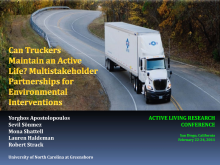We are pleased to announce an exciting new alliance between Active Living Research and GP RED to co-host and coordinate...
Can Truckers Maintain an Active Life? Multistakerholder Partnerships for Environmental Interventions

Presentation at the 2011 Active Living Research Annual Conference
Background:
Employment in the trucking sector has been linked to particularly high morbidity and mortality rates. The trucking milieu places significant strains on truck drivers and creates barriers for active living, which in turn increase risks for obesity-associated morbidities. Despite growing recognition of the importance of environmental determinants in shaping health behaviors, the role of the “transportation environment” (government regulations, trucking operations, corporate policies, and built environment) in elevating truckers’ risk for obesity remains largely unknown. We assume that truckers’ obesity-associated morbidities are predominantly attributable to a “transportation environment” that hinders active living and healthful diets. Although the workplace has been identified as a promising setting for health promotion, such programs in the trucking sector have been few, small-scale, compartmentalized, inefficiently-run, and mostly underfunded.
Objectives:
Grounded in ecosocial theoretical frameworks, this paper: (1) examines how the environmental attributes of trucking worksites influence truckers’ physical and recreational activity (PRA) patterns, and (2) outlines multistakeholder, environmental-level health promotion interventions.
Methods:
We used the “Healthy Trucking Worksites Audit Instrument” (HEATWAI) to collect environmental-level data from 25 trucking worksites near I-85 and I-40 highways in North Carolina. HEATWAI was specifically designed to assess the health-promotive characteristics of trucking worksites and examine how they can influence the PRA and dietary patterns of truckers and others working in the transportation/warehousing sector (k=0.87). Data analysis included descriptive statistics and interrater correlation analysis to establish HEATWAI’s psychometric attributes. The large number of items warranted the establishment of several summary scales: when a scale’s total score represents 90-100% of the maximum possible score, the trucking worksite is deemed fully supportive of active living; for 75-89.9%, mostly supportive; for 50-74.9%, partially supportive; for 35-49.9%, barely supportive; and <35%, not at all supportive.
Results:
(1) Physical/built environment: presence of green space, vegetation and stairwells was recorded and scored 182 from 655 possible points (27.8% active-living support). (2) PRA resources: presence of outdoor walking/running trails and in/outdoor recreational facilities was scored 126/469 possible points (26.9% active-living support). (3) Exercise/fitness facilities: presence of fitness facilities was not expected, however, some existence of dual-purpose space was anticipated due to high volume of truckers passing through truckstops. Zero out of 25 worksites had a room with exercise equipment. In light of these three scales, the Active-Living Index was 20.6%, which indicates that trucking worksites are not-at-all supportive of active living. (4) Active-living-promotive media: bulletin boards, brochures, and fliers with PRA messages were recorded, with a total score of 24/125 possible points (19.2% promotive of active living). (5) Active-living-promotive social environment: zero out of 25 worksites offered fitness memberships, incentives for PRA participation, or health risk appraisals. The active-living support rating for the social environment was only 8.2%. (6) Active-living-promotive environment of surrounding communities: all recorded PRA amenities were scored 46/325 possible points - overall community active-living support was found to be 14.2%. The abysmal performance of trucking worksites vis-à-vis their active-living support is not surprising. Truckers’ increases in obesity-associated morbidities cannot be explained merely by genetic/individual factors. The need for worksite health promotion (WHP) programs focusing on improving active-living environments of trucking worksites and on promoting an overall healthier work environment is worthy of attention. The current paradigm entailing mostly an occupational safety approach or small-scale, individually-tailored wellness programs has become obsolete. There is strong evidence that WHP programs can be significantly more effective when they integrate occupational safety with health promotion because they can collectively enhance both the health and safety of working people. In trucking, this holistic approach of multicomponent active-living health promotion would target a wide range of risk factors (including lack of truckstop fitness facilities) at several intertwined levels: truckers’ lifestyles, federal government regulations, trucking-sector operations, corporate policies in trucking worksites, trucking built-environment, as well as the full spectrum of the trucking environment. As per this approach, trucking stakeholders (i.e., union leaders, CEOs of trucking companies and truckstops, health insurance firms) would be co-responsible for a comprehensive and evolving WHP with integrated monitoring and evaluation components. The main thrust of this rationale incorporates the fact that WHP and occupational safety and health provide two parallel pathways for promoting trucker health, which will be significantly strengthened when coordinated and integrated rather than separate and independent.
Conclusions:
Findings corroborate anecdotal and empirical evidence supporting that trucking worksites remain active-living deserts contributing significantly to truckers’ obesity-associated comorbidities. This paper places the highly-underserved transportation/warehousing sector firmly within the discourse of WHP and occupational health disparities. It calls for comprehensive multistakeholder, multilevel wellness strategies that encompass the plethora of intertwined risk factors linked with individual, organizational, and environmental domains of truckers, other employees and the transportation environment.
STAY UP TO DATE
RECENTLY ADDED TOOLS & RESOURCES
MOVE! A BLOG ABOUT ACTIVE LIVING
The "Active Living Conference" aims to break down research and practice silos and...







